Spatial Matching and Policy-Planning Evaluation of Urban Elderly Care Facilities Based on Multi-Agent Simulation: Evidence from Shanghai, China
Abstract
:1. Introduction
2. Overview of Research Area
3. Materials and Methods
3.1. Data Sources
3.2. Research Methods
3.2.1. Agent-Based-Simulation-Analysis Method
3.2.2. Multi-Agent Micro-Simulation Model for Facility Configuration of Elderly Care Institutions
- Actor behavior of the elderly
- 2.
- Actor behavior of elderly care institutions
- 3.
- Inter-actor and actor–environment interaction
4. Results
4.1. Simulation of Supply of and Demand for Facilities in Shanghai Elderly Care Institutions
4.1.1. The Number and Disability Rate of the Elderly Population
4.1.2. Demand for Beds in Elderly Care Institutions
4.2. Rationality Evaluation of Space Allocation of Elderly Care Institutions
4.2.1. Evaluation Index of Spatial Allocation Rationality of Elderly Care Institutions
4.2.2. Rationality of Spatial Allocation of Elderly Care Institutions in Shanghai
5. Discussion
5.1. Institutional Care Needs and Spatial Matching of Elderly Care Institutions
5.2. Suggestions
6. Conclusions
Funding
Institutional Review Board Statement
Informed Consent Statement
Data Availability Statement
Conflicts of Interest
References
- Gao, X.; Wu, D.; Xu, Z.; Yan, B. A Review and Framework Setting of Geographical Research on Aging in China. Prog. Geogr. 2015, 34, 1480–1494. [Google Scholar]
- Skinner, M.W.; Andrews, G.J.; Cutchin, M.P. Geographical Gerontology: Perspectives, Concepts, Approaches; Routledge: London, UK, 2017; ISBN 9781315281193. [Google Scholar]
- Xie, B.; Zhou, J.; Luo, X. Mapping Spatial Variation of Population Aging in China’s Mega Cities. J. Maps 2016, 12, 181–192. [Google Scholar] [CrossRef] [Green Version]
- Zhou, J. Spatial Distribution Characteristics and Evolution Trends of Urban Aging Population. China City Plan. Rev. 2017, 26, 6–15. [Google Scholar]
- Zhang, F.; Li, D.; Ahrentzen, S.; Zhang, J.K. Assessing Spatial Disparities of Accessibility to Community-based Service Resources for Chinese Older Adults Based on Travel Behavior: A City-wide Study of Nanjing, China. Habitat. Int. 2019, 88, 101984. [Google Scholar] [CrossRef]
- Rowles, G.D. Environmental Gerontology: Making Meaningful Places in Old Age; Springer Publishing Company: Berlin/Heidelberg, Germany, 2013; ISBN 9780826108142. [Google Scholar]
- Yan, B.; Gao, X.; Ji, J. Micro Simulation and Planning Policies Analysis for Urban Elderly Care Facilities: Take Beijing as an Example. Prog. Geogr. 2015, 34, 1586–1597. [Google Scholar]
- The State Council of the PRC. National Plan for the Development of the Elderly Care Services System during the 14th Five-Year Plan Period (2021–2025). Available online: https://www.mca.gov.cn/article/xw/mtbd/202202/20220200039833.shtml (accessed on 11 October 2022).
- Tao, Z.; Han, W. Assessing the Impacts of Hierarchical Healthcare System on the Accessibility and Spatial Equality of Healthcare Services in Shenzhen, China. ISPRS Int. J. Geo-Inf. 2021, 10, 615. [Google Scholar] [CrossRef]
- Cheng, Y.; Gao, S.Y.; Li, S.; Zhang, Y.C.; Rosenberg, M. Understanding the Spatial Disparities and Vulnerability of Population Aging in China. Asia Pac. Policy Stud. 2019, 6, 73–89. [Google Scholar] [CrossRef]
- Lu, M. Integration, Development, and Balance: China’s New Urbanization Strategy Should Be Led by Mega-Cities. China Econ. Transit. = Dangdai Zhongguo Jingji Zhuanxing Yanjiu 2018, 1, 81–86. [Google Scholar]
- Schwanen, T.; Hardill, I.; Lucas, S. Spatialities of Ageing: The Co-construction and Co-evolution of Old Age and Space. Geoforum 2012, 43, 1291–1295. [Google Scholar] [CrossRef]
- Wu, H.-C.; Tseng, M.-H. Evaluating Disparities in Elderly Community Care Resources: Using a Geographic Accessibility and Inequality Index. Int. J. Environ. Res. Public Health 2018, 15, 1353. [Google Scholar] [CrossRef] [Green Version]
- Rishworth, A.; Elliott, S.J. Global Environmental Change in an Aging World: The Role of Space, Place and Scale. Soc. Sci. Med. 2019, 227, 128–136. [Google Scholar] [CrossRef] [PubMed]
- Liu, L.; Lyu, H.; Zhao, Y.; Zhou, D. An Improved Two-Step Floating Catchment Area (2SFCA) Method for Measuring Spatial Accessibility to Elderly Care Facilities in Xi’an, China. Int. J. Environ. Res. Public Health 2022, 19, 11465. [Google Scholar] [CrossRef] [PubMed]
- Huang, X.; Gong, P.; White, M. Study on Spatial Distribution Equilibrium of Elderly Care Facilities in Downtown Shanghai. Int. J. Environ. Res. Public Health 2022, 19, 7929. [Google Scholar] [CrossRef] [PubMed]
- Andrews, G.J.; Phillips, D.R. Ageing and Place: Perspectives, Policy Practice; Routledge: London, UK, 2005. [Google Scholar]
- McGrail, M.R. Spatial Accessibility of Primary Health Care Utilising the Two Step Floating Catchment Area Method: An Assessment of Recent Improvements. Int. J. Health Geogr. 2012, 11, 50. [Google Scholar] [CrossRef]
- Di, X.; Wang, L.; Dai, X.; Yang, L. Assessing the Accessibility of Home-Based Healthcare Services for the Elderly: A Case from Shaanxi Province, China. Int. J. Environ. Res. Public Health 2020, 17, 7168. [Google Scholar] [CrossRef]
- Cottrill, C.; Gaglione, F.; Gargiulo, C.; Zucaro, F. Defining the Characteristics of Walking Paths to Promote an Active Ageing. In Pedestrians, Urban Spaces and Health; CRC Press: Boca Raton, FL, USA, 2020; pp. 209–213. [Google Scholar]
- Guagliardo, M.F. Spatial Accessibility of Primary Care: Concepts, Methods and Challenges. Int. J. Health Geogr. 2004, 3, 3. [Google Scholar] [CrossRef] [Green Version]
- Wang, F. Measurement, Optimization and Impact of Healthcare Accessibility: A Methodological Review. Ann. Assoc. Am. Geogr. 2012, 102, 1104–1112. [Google Scholar] [CrossRef] [Green Version]
- Zhang, L.; Zeng, Y.; Fang, Y. Evaluating the Technical Efficiency of Care among Long-term Care Facilities in Xiamen, China: Based on Data Envelopment Analysis and Tobit Model. BMC Public Health 2019, 19, 1230. [Google Scholar] [CrossRef] [Green Version]
- Garavaglia, G.; Lettieri, E.; Agasisti, T.; Lopez, S. Efficiency and Quality of Care in Nursing Homes: An Italian Case Study. Health Care Manag. Sci. 2011, 14, 22–35. [Google Scholar] [CrossRef]
- Xu, X.; Zhou, L.; Antwi, H.A.; Chen, X. Evaluation of Health Resource Utilization Efficiency in Community Health Centers of Jiangsu Province, China. Hum. Resour. Health 2018, 16, 13. [Google Scholar] [CrossRef]
- Lawton, M.P.; Nahemow, L. Ecology and the Aging Process. In The Psychology of Adult Development and Aging; Eisdorfer, C., Lawton, M.P., Eds.; American Psychological Association: Washington, DC, USA, 1973; pp. 619–674. [Google Scholar]
- Yu, J.; Rosenberg, M.W. Aging and the Changing Urban Environment: The Relationship between Older People and the Living Environment in Post-reform Beijing, China. Urban Geogr. 2020, 41, 162–181. [Google Scholar] [CrossRef] [Green Version]
- Davern, M.; Winterton, R.; Brasher, K.; Woolcock, G. How Can the Lived Environment Support Healthy Ageing? A Spatial Indicators Framework for the Assessment of Age-Friendly Communities. Int. J. Environ. Res. Public Health 2020, 17, 7685. [Google Scholar] [CrossRef] [PubMed]
- Zhou, J.; Chai, Y. Research Progress on Spatial Behaviors of the Elderly in China. Prog. Geogr. 2013, 32, 722–732. [Google Scholar]
- McGrail, M.R.; Humphreys, J.S. Measuring Spatial Accessibility to Primary Health Care Services: Utilising Dynamic Catchment Sizes. Appl. Geogr. 2014, 54, 182–188. [Google Scholar] [CrossRef]
- Wang, C.; Wu, G.; Zhang, C. Research on Spatial Structure of the Chengdu-Chongqing Urban Agglomeration Based on the DMSP/OLS Nighttime Light Data. Urb. Dev. Stud. 2015, 22, 20–24. [Google Scholar]
- Tao, Z.; Cheng, Y.; Zheng, Q.; Li, G. Measuring Spatial Accessibility to Health Care Services with Constraint of Administrative Boundary: A Case Study of Yanqing District, Beijing, China. Int. J. Equity Health 2018, 17, 7. [Google Scholar] [CrossRef] [PubMed]
- Chen, H.; Hao, L.; Yang, C.; Yan, B.; Sun, Q.; Sun, L.; Chen, H.; Chen, Y. Understanding the rapid increase in life expectancy in shanghai, China: A population-based retrospective analysis. BMC Public Health 2018, 18, 256. [Google Scholar] [CrossRef] [Green Version]
- Shanghai Municipal Health Commission. Monitoring and Statistical Information of the Elderly Population and Elderly Cause in Shanghai in 2021. Available online: http://wsjkw.sh.gov.cn/tjsj2/20220728/23e3fe0692d744a6b994309de7b2493d.html (accessed on 28 July 2022).
- Li, X.; Ye, J. Constrained Cellular Automata for Modelling Sustainable Urban Forms. Acta Geogr. Sin. 1999, 54, 289–298. [Google Scholar]
- Batty, M.; Jiang, B. Multi-Agent Simulation: Computational Dynamics within GIS//GIS and Geocomputation; CRC Press: Boca Raton, FL, USA, 2000; pp. 67–84. ISBN 9780429180828. [Google Scholar]
- Davidsson, P. Multi-agent-based Simulation: Beyond Social Simulation. In Proceedings of the International Workshop on Multi-Agent Systems and Agent-Based Simulation, Boston, MA, USA, 1 January 2001; Springer: Berlin/Heidelberg, Germany, 2001. [Google Scholar]
- Wooldridge, M. Intelligent agents: Theory and practice. Knowl. Eng. Rev. 1995, 10, 115–152. [Google Scholar] [CrossRef] [Green Version]
- Minsky, M. The Society of Mind; Simon and Schuster: New York, NY, USA, 1986. [Google Scholar]
- Chen, W.; Gao, X.; Shen, Z. Application of Multi-agent System in Simulation of Urban Development: A Review. Prog. Geogr. 2012, 31, 761–767. [Google Scholar]
- Small, N.R. Self-care in Institutional Settings. Generations 1993, 17, 19–23. [Google Scholar]
- Zhang, L.; Zeng, Y.; Fang, Y. The Effect of Health Status and Living Arrangements on Long Term Care Models among Older Chinese: A Cross-sectional Study. PLoS ONE 2017, 12, e0182219. [Google Scholar] [CrossRef] [Green Version]
- Gu, D.; Yin, Y.; Zhou, J.; Sautter, J.; Li, Q. Homeownership among Older Adults in Urban China: The Importance of Institutional Factors. J. Cross-Cult. Gerontol. 2016, 31, 337–355. [Google Scholar] [CrossRef] [PubMed]
- Zhongyan Puhua Industrial Research Institute. Analysis on the Current Situation and Development Prospect of the Elderly Care Industry in 2022. Available online: https://www.chinairn.com/news/20220801/170326187.shtml (accessed on 24 June 2022).
- Long, Y.; Shen, Z.J.; Mao, Q.Z. Retrieving Individual Attributes from Aggregate Dataset for Urban Micro-simulation: A Pre-liminary Exploration. Acta Geogr. Sin. 2011, 66, 416–426. [Google Scholar]
- Rai, V.; Robinson, S.A. Agent-based Modeling of Energy Technology Adoption: Empirical Integration of Social, Behavioral, Economic, and Environmental Factors. Environ Modell. Softw. 2015, 70, 163–177. [Google Scholar] [CrossRef] [Green Version]
- Shanghai Municipal Civil Affairs Bureau. Special Plan for the Layout of Elderly Care Service Facilities in Shanghai (2021–2035). Available online: https://mzj.sh.gov.cn/MZ_zhuzhan23_0-2-8/20220224/4684a2ff047043358e92a6f7669aba11.html (accessed on 24 February 2022).
- Huang, Y.; Meyer, P.; Jin, L. Spatial Access to Health Care and Elderly Ambulatory Care Sensitive Hospitalizations. Public Health 2019, 169, 76–83. [Google Scholar] [CrossRef]
- Tao, Z.; Cheng, Y.; Dai, T.; Rosenberg, M.W. Spatial Optimization of Residential Care Facility Locations in Beijing, China: Maximum Equity in Accessibility. Int. J. Health Geog. 2014, 13, 33. [Google Scholar] [CrossRef] [Green Version]
- Gao, Y.Y.; Li, Z.; Zhu, G.; Zheng, Z. Spatial Allocation of Urban Medical Facilities for the Elderly in China: With Hefei City as Example. China City Plan. Rev. 2019, 28, 6–17. [Google Scholar]
- Cheng, T.; Liu, C.; Yang, H.; Wang, N.; Liu, Y. From Service Capacity to Spatial Equity: Exploring a Multi-Stage Decision-Making Approach for Optimizing Elderly-Care Facility Distribution in the City Centre of Tianjin, China. Sustain. Cities Soc. 2022, 85, 104076. [Google Scholar] [CrossRef]
- Yu, S.; Li, W. Research on the Application of GIS in the Problem of Aging. In Proceedings of the 2019 4th International Conference on Humanities Science and Society Development (ICHSSD 2019), Xiamen, China, 24–26 May 2019; Atlantis Press: Dordrecht, The Netherlands, 2019. [Google Scholar]
- He, C.; Han, Q.; de Vries, B.; Wang, X.; Zhao, G. Evaluation of Sustainable Land Management in Urban Area: A Case Study of Shanghai, China. Ecol. Indic. 2017, 80, 106–113. [Google Scholar] [CrossRef]
- Theobald, H. Social Exclusion and Care for the Elderly: Theoretical Concepts and Changing Realities in European Welfare States; WZB Discussion Paper; WZB: Berlin, Germany, 2005. [Google Scholar]
- Oliver, C. Retirement Migration: Paradoxes of Ageing; Routledge: London, UK, 2007; ISBN 9780203942307. [Google Scholar]
- Shanghai Data News Center. Interpreting the Data of 733 Elderly Care Institutions in Shanghai, the Elderly Care Is Not So Simple. Available online: https://www.thepaper.cn/newsDetail_forward_3670039 (accessed on 18 June 2019).
- Rogers, A.; Pilgrim, D. A Sociology of Mental Health and Illness; McGraw-Hill Education: New York, NY, USA, 2014; ISBN 9781315281193. [Google Scholar]
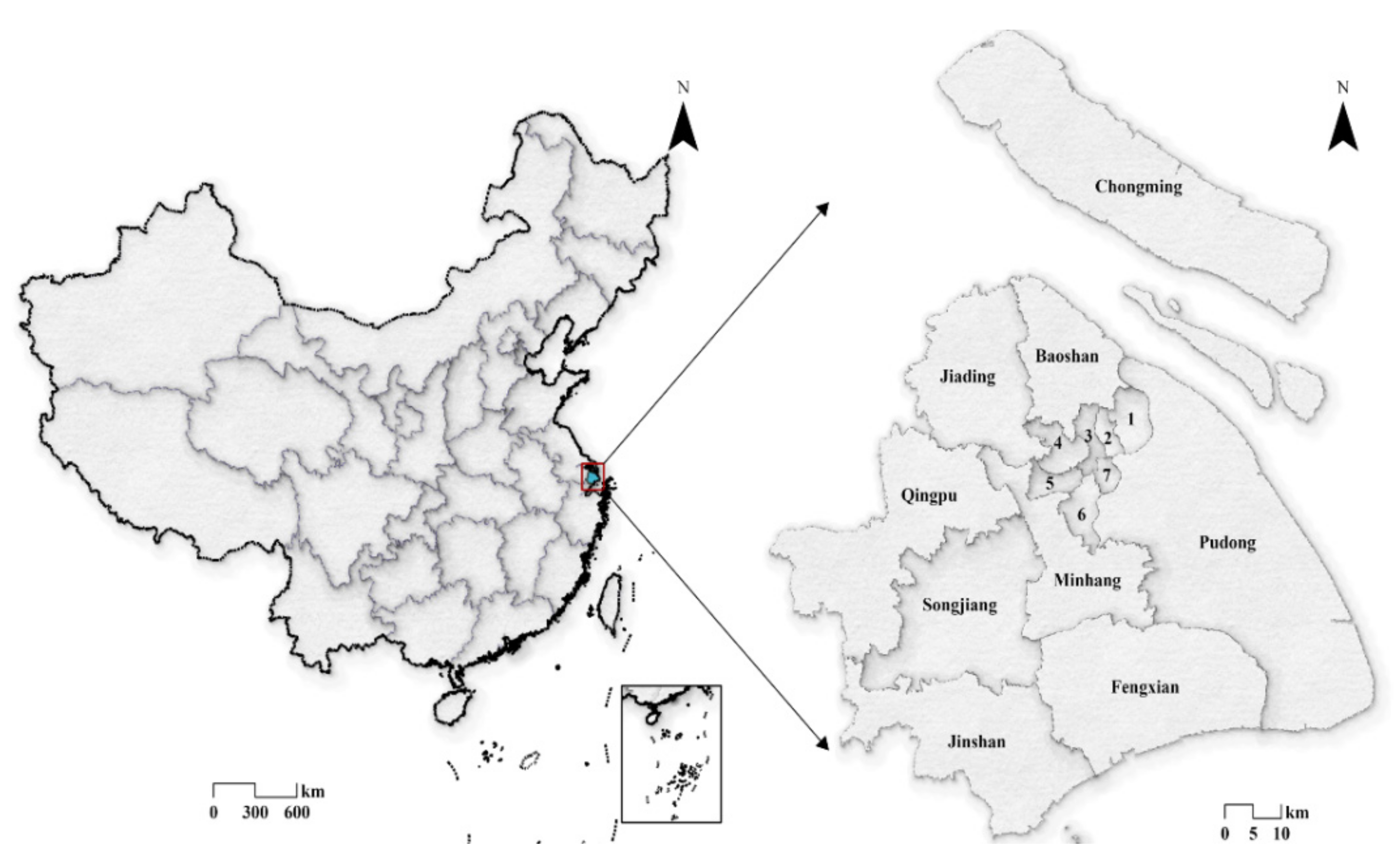

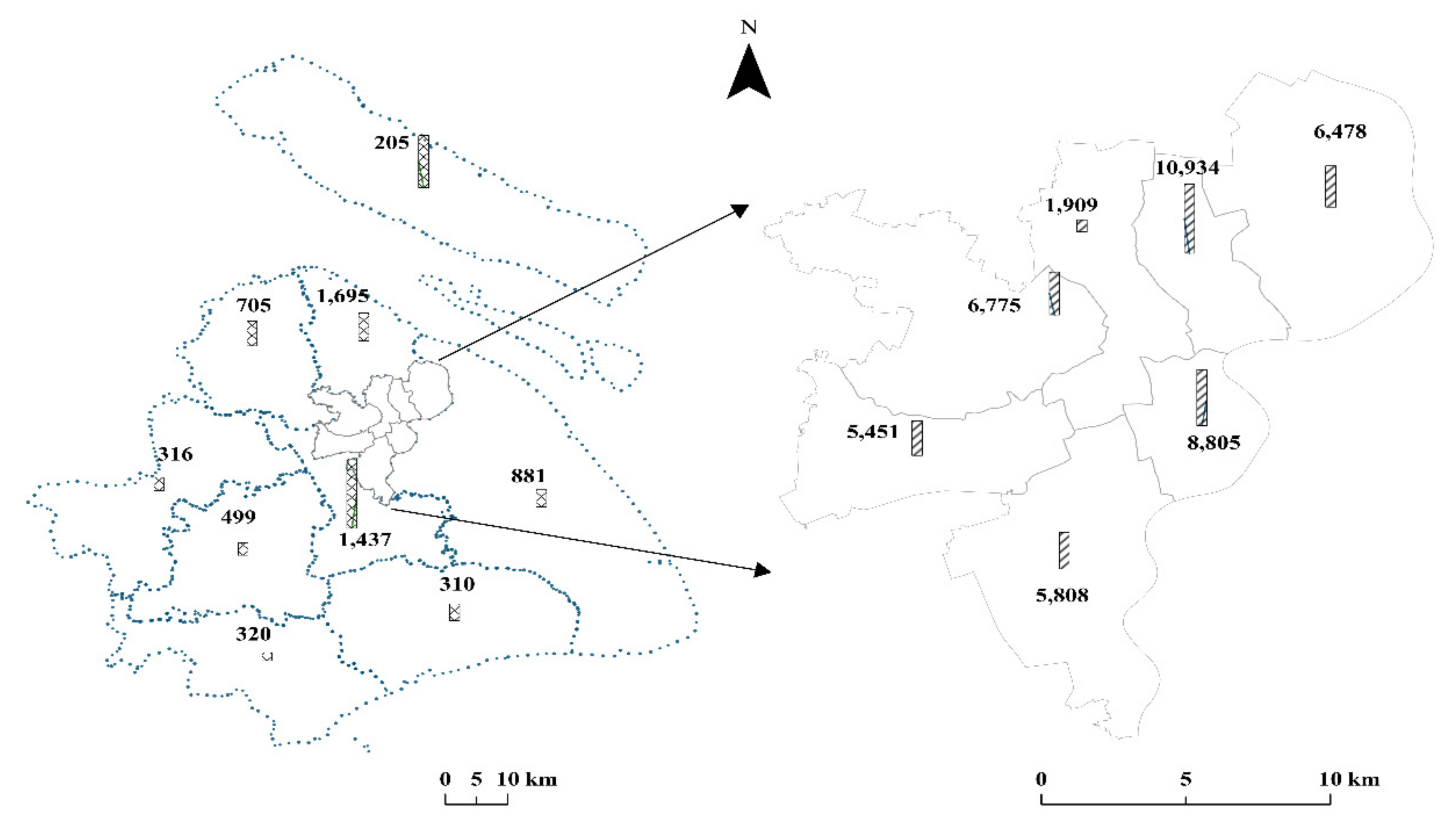
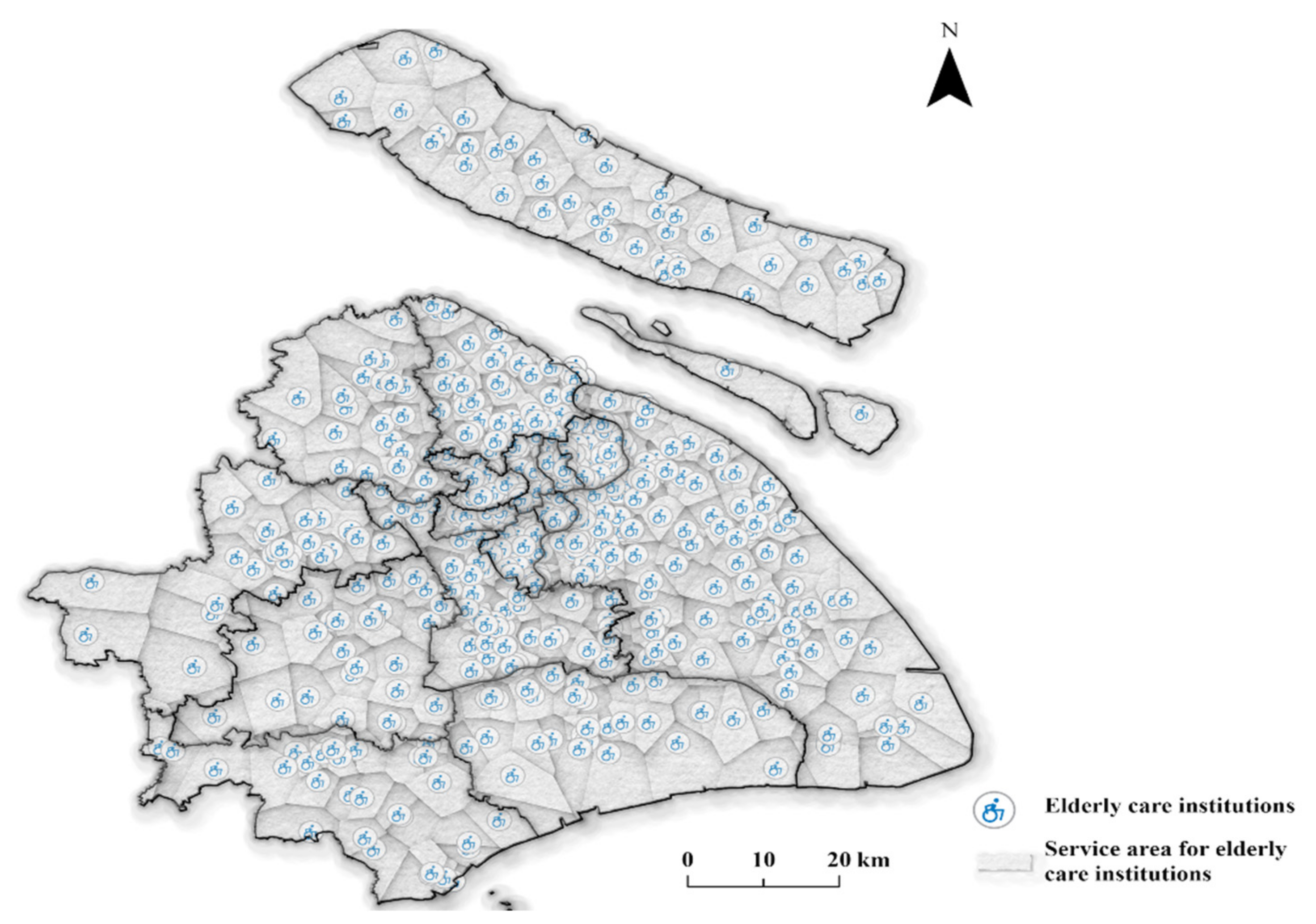
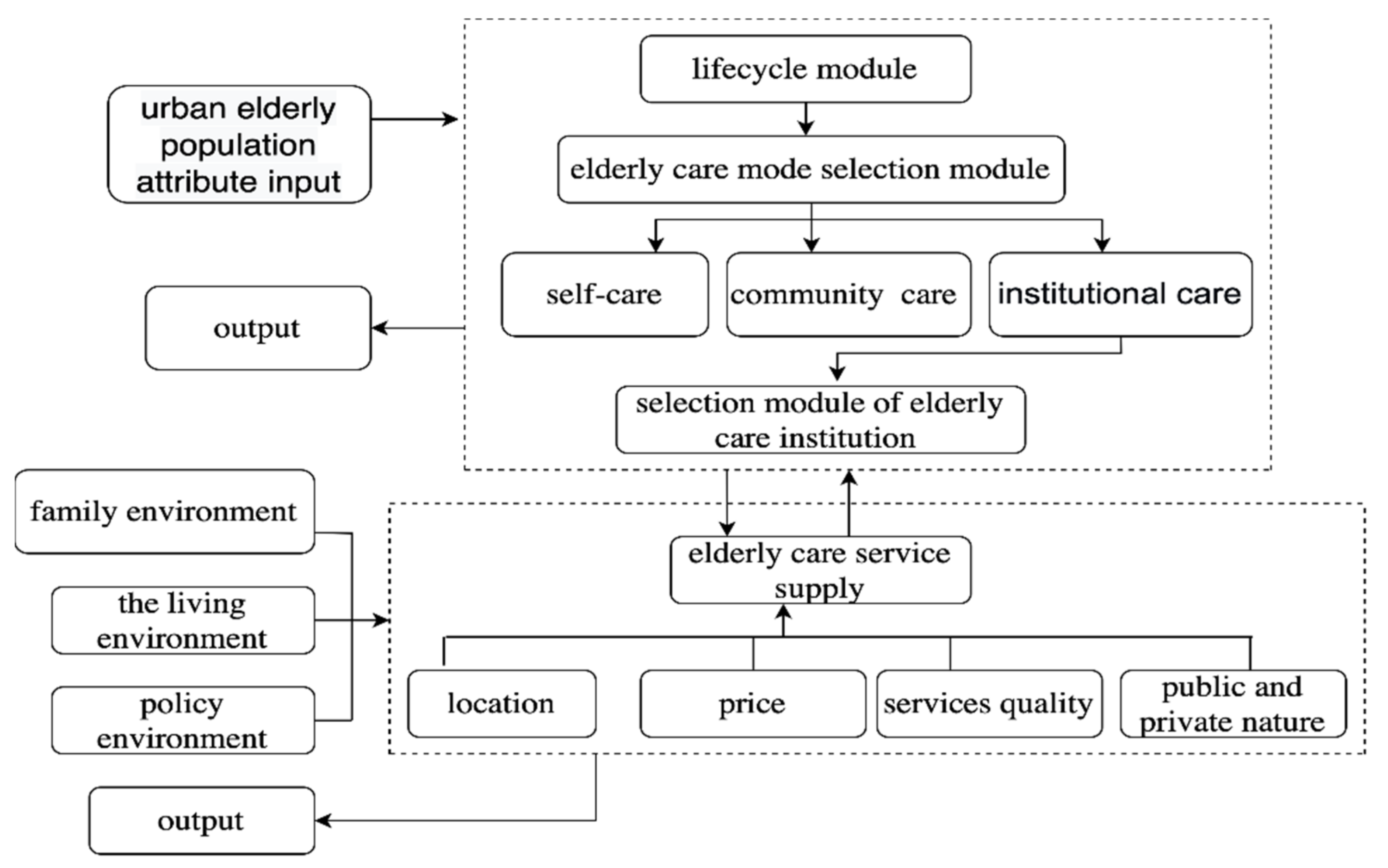


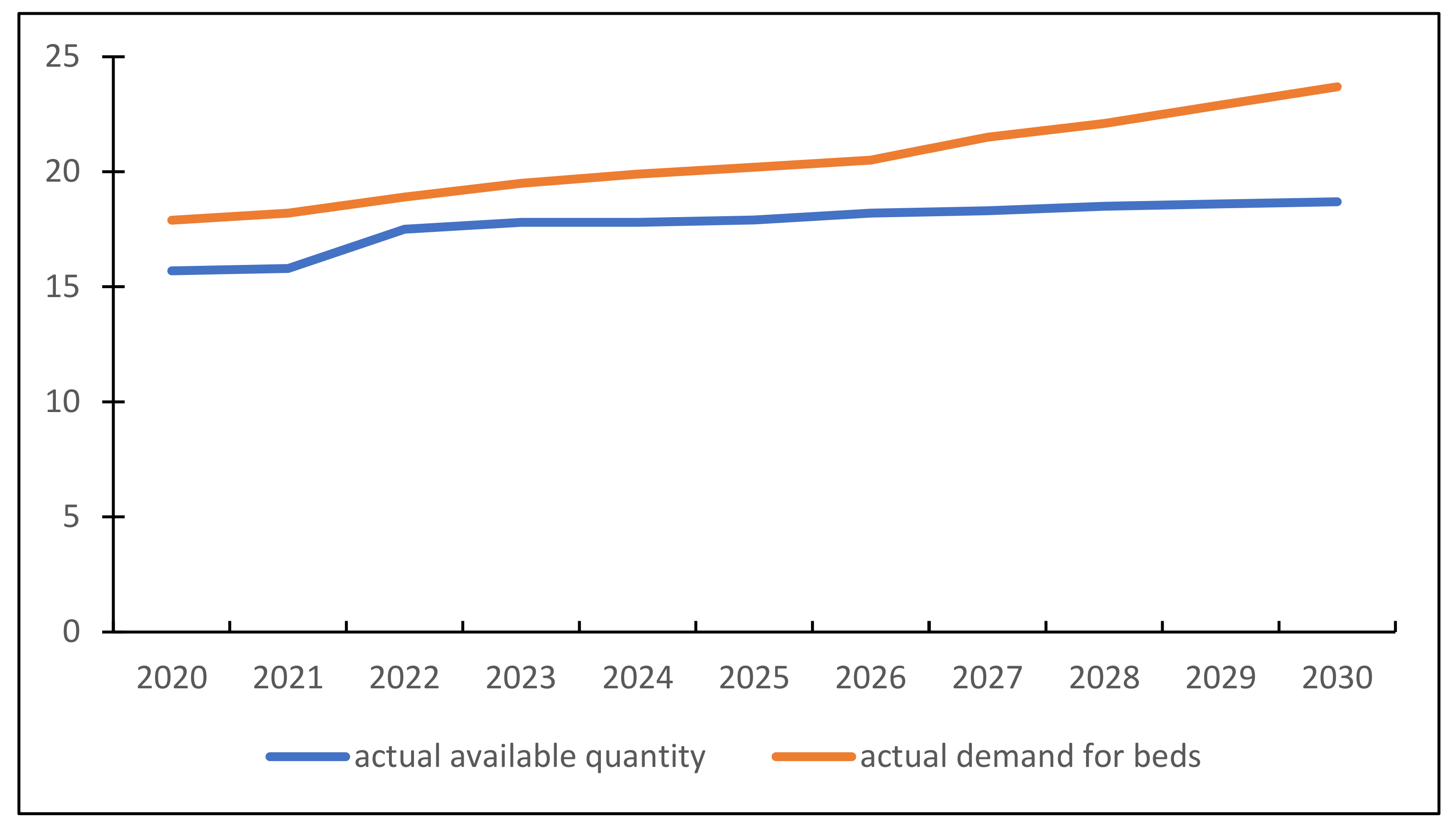


Publisher’s Note: MDPI stays neutral with regard to jurisdictional claims in published maps and institutional affiliations. |
© 2022 by the author. Licensee MDPI, Basel, Switzerland. This article is an open access article distributed under the terms and conditions of the Creative Commons Attribution (CC BY) license (https://creativecommons.org/licenses/by/4.0/).
Share and Cite
Zhu, H. Spatial Matching and Policy-Planning Evaluation of Urban Elderly Care Facilities Based on Multi-Agent Simulation: Evidence from Shanghai, China. Sustainability 2022, 14, 16183. https://doi.org/10.3390/su142316183
Zhu H. Spatial Matching and Policy-Planning Evaluation of Urban Elderly Care Facilities Based on Multi-Agent Simulation: Evidence from Shanghai, China. Sustainability. 2022; 14(23):16183. https://doi.org/10.3390/su142316183
Chicago/Turabian StyleZhu, Hao. 2022. "Spatial Matching and Policy-Planning Evaluation of Urban Elderly Care Facilities Based on Multi-Agent Simulation: Evidence from Shanghai, China" Sustainability 14, no. 23: 16183. https://doi.org/10.3390/su142316183
APA StyleZhu, H. (2022). Spatial Matching and Policy-Planning Evaluation of Urban Elderly Care Facilities Based on Multi-Agent Simulation: Evidence from Shanghai, China. Sustainability, 14(23), 16183. https://doi.org/10.3390/su142316183




